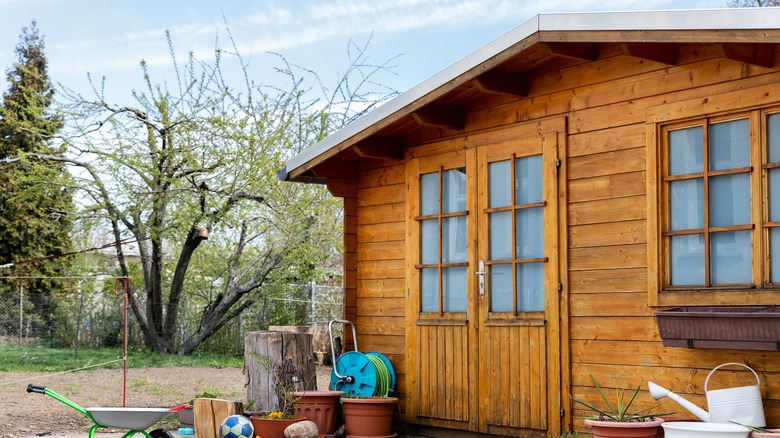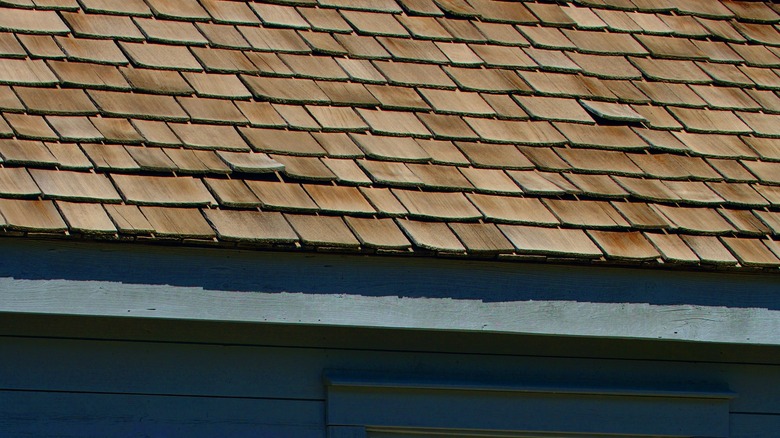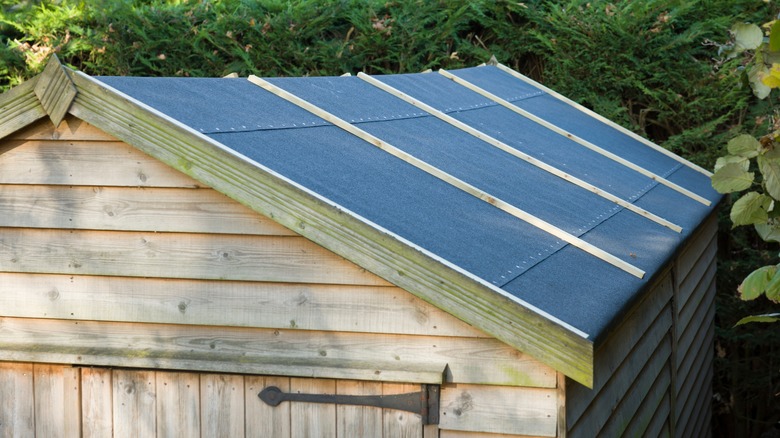The Long-Lasting Shed Roof Material That's Worth The Price (& 1 That Isn't)
Picking the best roof is one of the most consequential decisions you'll make when building a shed. The shed's roofing fulfills an important function by keeping moisture out of the space and away from the structural members. But, roofing is exposed to rainwater, snow, ice, high winds, and relentless sun, and not all materials withstand these elements the same way. If you want your shed's roof to serve its purpose well and keep the shed dry many years after installation, you'll have to pick a material that's up to the task. Not to mention that your choice of roofing material affects the shed's appearance. And the best roofing material — one that ticks all the functionality, durability, and aesthetics boxes — is, by far, cedar.
You are probably thinking about saving money on the cost of your shed. Now, cedar shakes are not exactly cheap compared to other roofing materials, like asphalt shingles or felt. You may pay up to $15 per square foot for this material. But, the advantages outweigh the price. That's because cedar shakes last around 35 years — 10 years longer than other roofing materials. They also withstand severe weather without sustaining damage and repel bugs naturally. What's more, the warm, natural look of cedar on your shed is unmatched. Despite its advantages, cedar shakes have a few characteristics that entail special care on your part. Below, we'll explain everything you need to know about wood shingles before you install them on your shed (and tell you which material isn't worth your money).
Things to know before installing cedar shakes on your shed's roof
Cedar is a fantastic material for outdoor applications. But, despite cedar's ability to resist the elements and insects, it's sensitive to changes in moisture and temperature, responding to them by shrinking and expanding. You must give the shingles time to acclimate to your local weather conditions before installing them; otherwise, they'll change their shape once on the roof and become misaligned. Even when acclimated, cedar shakes expand and contract a bit in response to weather changes, and you'll have to account for these movements, leaving a keyway between them during installation. Typically, you'll need to provide at least a ¼-inch of space between the cedar shakes, and make sure they're lined up correctly.
Like all wood shingles, cedar shakes need breathing room so the rainwater they absorb can evaporate. You'll need to ensure that these shingles are properly ventilated when you install them. To promote ventilation, you'll have to install wood spacers that leave room for air movement beneath the shingles, along with a skip sheathing layer.
One final thing to note is that cedar shakes are particular about what fasteners you use to attach them. Some nails — and tools like nail guns — can ruin cedar shakes during installation. Not only that, but not all nails are made to withstand moisture and corrosion. Use only aluminum, stainless steel, or galvanized steel nails when installing cedar shakes on the roof. Also, hammer the nails in by hand — don't rely on a nail gun!
Don't waste time or money on felt roofing
Felt is arguably the most traditional type of shed roofing, and its low price point is one of its most compelling draws. Felt can cost as little as 16 cents per square foot, and you may rightly think it's a steal. But felt roofing has several distinct disadvantages — some of which may well cost you more to remediate than what you've paid for the roof in the first place.
For one, installing felt roofing demands specialized knowledge. If you don't fold and fasten the material properly around the roof's edges and corners, the roof will not be waterproof. And if water gets under the felt, it can cause mold and even rot-related damage to the wooden roofing structure. Even if you follow the best practices when installing the felt, the nails you use to fasten it to the roof create penetrations that are tough to seal — again, exposing the structure below to water ingress. If you manage to plug all the gaps and prevent rainwater from getting inside, the felt just does not last very long. Its lifespan is further shortened by cold temperatures, which cause it to become brittle a few years into its service life. This brittleness leads to cracks, and, once again, moisture finding its way inside the roofing assembly. Finally, felt is also unsuitable for regions that are frequently battered by high winds, which cause the material to tear and let rainwater get inside.


